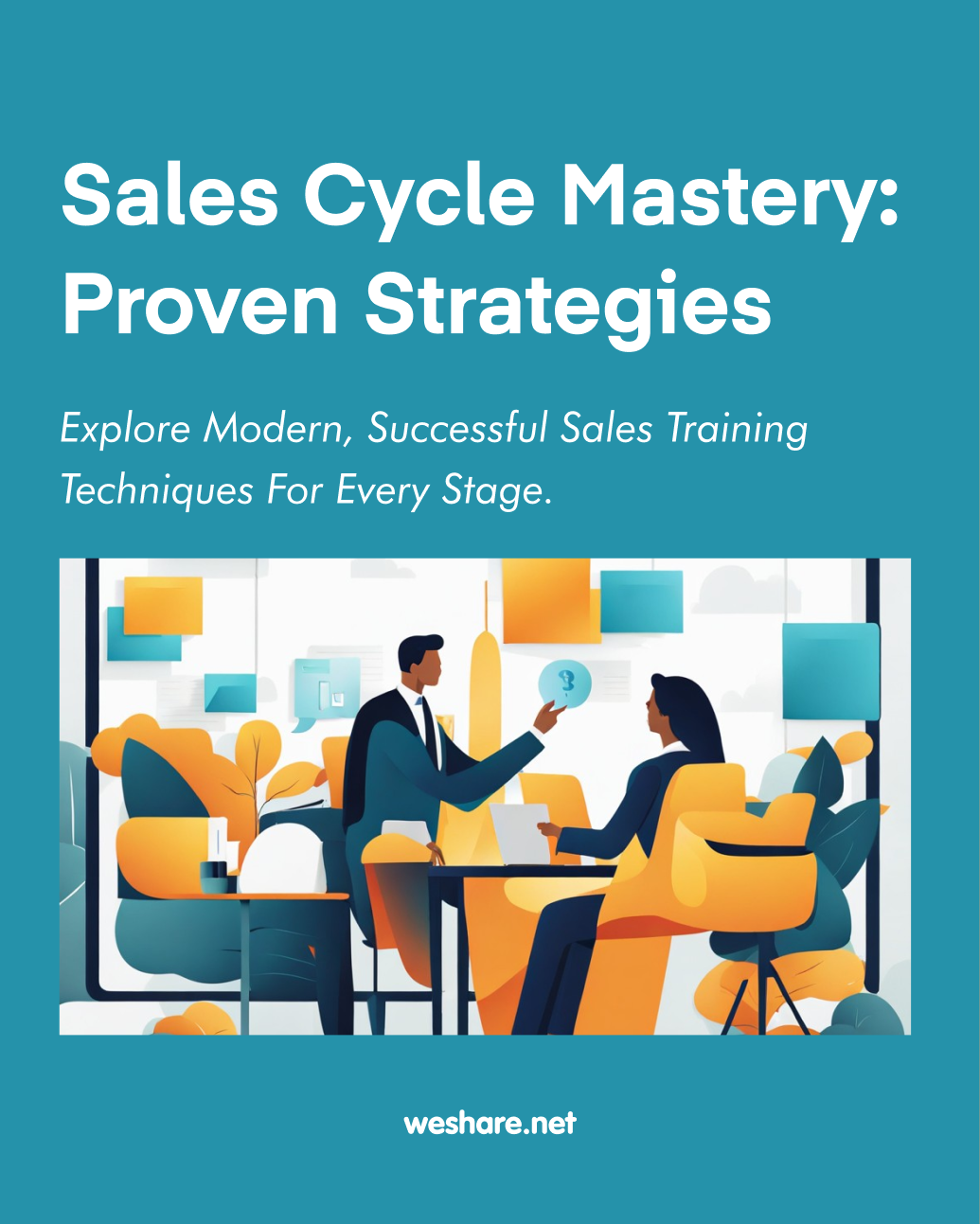Provided by Weshare.net, your go-to resource for the best tips and information about sales.
Introduction
Mapping out the sales cycle is crucial for understanding and optimizing the sales process. This template provides a structured approach to identify each stage of the sales cycle, along with strategies and key actions to enhance performance.
Understanding the Sales Cycle Stages
Before diving into the template, it’s essential to understand the typical stages of a sales cycle:
- Prospecting: Identifying potential customers.
- Initial Contact: Making the first connection.
- Qualification: Assessing the potential customer’s fit and interest.
- Presentation: Demonstrating the value of the product or service.
- Handling Objections: Addressing any concerns or hesitations.
- Closing: Finalizing the sale.
- Follow-Up: Maintaining the relationship post-sale.
| Stage | Description | Strategy | Key Actions | Examples |
| 1. Prospecting | Identifying potential customers | Research and qualify leads | – Use social media and online tools for lead generation – Attend networking events | – Researching industries on LinkedIn – Participating in trade shows |
| 2. Initial Contact | First communication with prospects | Establish contact and gauge interest | – Send personalized emails – Make cold calls | – Emailing a tailored proposal – Cold calling with a script focused on customer needs |
| 3. Qualification | Understanding customer needs | Analyze and identify customer challenges | – Conduct surveys or interviews – Review customer feedback | – Online surveys about product preferences – In-depth interviews with potential clients |
| 4. Presentation | Presenting the product/service | Tailor solutions to customer needs | – Create customized presentations – Offer detailed proposals | – Customized demo of a product – Detailed service proposal with benefits outlined |
| 5. Handling Objections | Addressing concerns or hesitations | Provide solutions and reassurances | – Anticipate common objections – Develop responses and alternatives | – FAQ document addressing common concerns – Case studies demonstrating success |
| 6. Closing | Finalizing the deal | Secure commitment | – Negotiate terms – Prepare contracts | – Price negotiation tactics – Ready-to-sign contract templates |
| 7. Follow-up | Post-sale relationship management | Maintain customer relationships | – Offer after-sale support – Request feedback | – Customer satisfaction surveys – Exclusive offers for repeat business |
This table serves as a template and can be customized to fit the specific needs and nuances of different businesses and industries.
Sales Cycle Mapping and Strategy Template
This template is structured to allow businesses to define each stage of their sales cycle and tailor strategies for their specific context.
Stage 1: Prospecting
- Description: Identifying potential customers through market research, networking, etc.
- Key Actions:
- Use social media for targeted outreach.
- Attend industry events and webinars.
Stage 2: Initial Contact
- Description: First communication with potential customers.
- Key Actions:
- Personalize email templates for different customer segments.
- Use engaging and clear subject lines in emails.
Stage 3: Qualification
- Description: Evaluating if the prospect fits the product/service.
- Key Actions:
- Develop a qualification checklist.
- Conduct need-analysis calls.
Stage 4: Presentation
- Description: Demonstrating the product’s value.
- Key Actions:
- Create customizable presentation templates.
- Focus on solving specific customer problems.
Stage 5: Handling Objections
- Description: Addressing concerns and hesitations of the customer.
- Key Actions:
- Prepare responses for common objections.
- Train sales team on objection handling techniques.
Stage 6: Closing
- Description: Finalizing the sale.
- Key Actions:
- Offer time-sensitive discounts.
- Use assumptive closing techniques.
Stage 7: Follow-Up
- Description: Post-sale relationship management.
- Key Actions:
- Send thank you emails and customer satisfaction surveys.
- Offer after-sales support and check-ins.
Best Practices for Implementing the Sales Cycle Strategy
- Continuously Monitor and Adapt: Regularly review and adjust strategies for each stage.
- Train Your Team: Ensure your sales team is well-trained in each stage’s strategies.
- Leverage Technology: Use CRM tools to automate and track processes.
- Customer Feedback: Regularly gather and incorporate customer feedback.
Note: This template is a starting point and should be customized according to your business needs and customer profiles.
Incorporating this template into your sales strategy can significantly improve your sales process’s efficiency and effectiveness. By understanding each stage and implementing tailored actions, businesses can guide prospects smoothly through the sales cycle, increasing the chances of successful conversions.
Examples of Scripts and Templates for Different Stages
Stage 1: Prospecting Template
Social Media Outreach Message
Hi [Name],
I noticed your involvement in [Industry/Field] and thought our [Product/Service] might interest you.
It’s designed to help businesses like yours [Key Benefit]. Let’s connect!
Best,
[Your Name]
Networking Event Follow-Up Email
Subject: Great Connecting at [Event Name]
Hi [Name],
It was great meeting you at [Event Name]. I was impressed by your insights into [Topic Discussed].
I believe our [Product/Service] could add value to your [Specific Need].
Let’s chat more about this?
Cheers,
[Your Name]
Qualification Checklist Template
- Prospect’s Budget: _______
- Decision-Making Power: _______
- Need for Product/Service: _______
- Timeline for Purchase: _______
- Compatibility with Product/Service: _______
Stage 2: Initial Contact Template
Personalized Email Template
Subject: [Prospect’s Business] + [Your Company]: Unlocking New Opportunities
Hi [Prospect’s Name],
I’m [Your Name] from [Your Company]. We specialize in [Brief Description of Product/Service].
I believe there’s a great potential for synergy between our companies, especially in [Area of Prospect’s Business Needs].
Would you be open to a brief call this week to explore this?
Best regards,
[Your Name]
Stage 3: Qualification Template
Qualification Call Script
Hi [Prospect’s Name],
Thank you for taking the time to speak with me today.
I have a few questions to better understand your needs:
1. Can you tell me more about your current challenges in [Area of Interest]?
2. What does your ideal solution look like?
3. What is your timeframe for implementing a solution?
4. Who else, if anyone, will be involved in the decision-making process?
Looking forward to your thoughts.
Best,
[Your Name]
Stage 4: Presentation Template
Presentation Slide Outline
- Welcome Slide: Introduction to your company.
- Understanding Their Needs: Highlight the identified needs of the prospect.
- Our Solution: Detailed explanation of your product/service.
- Benefits: How your solution meets their needs.
- Customer Testimonials: Success stories and endorsements.
- Q&A: Inviting questions from the prospect.
Stage 5: Handling Objections Template
Objection Handling Script
Prospect: “Your product seems too expensive.”
Response: “I understand your concern about cost. Let’s explore the ROI our clients typically see and how it might offset the initial investment for your business.”
Stage 6: Closing Template
Closing Email
Subject: Ready to Take the Next Step?
Hi [Prospect’s Name],
Based on our discussions, I believe [Your Product/Service] is well-aligned with your goals, especially for [Specific Benefit].
As a reminder, we’re offering a [Discount/Offer] if we proceed by [Deadline].
I’m here to help with any final questions you have.
Best,
[Your Name]
Stage 7: Follow-Up Template
Thank You Email
Subject: Thank You for Choosing Us!
Hi [Customer’s Name],
Thank you for your trust in [Your Product/Service].
We are committed to your satisfaction and success. Please don’t hesitate to reach out if you need support or have questions.
Also, we’d appreciate your feedback via this short survey [Link to Survey].
Best regards,
[Your Customer Success Manager’s Name]
These templates can be customized to fit the specific needs and nuances of your business and target market.
Weshare’s Team – We’re in love with words, videos and everything in between. Our passion for helping people manage a business is evident in every article. We’re happy to be there in every part of the way – from starting to growing a successful business.
We Also Reviewed
- 45+ Advertising Statistics That Will Blow Your Mind
- 33 CRM Statistics You Should Know
- 41+ Public Speaking Statistics You Should Know
- 35 Machine Learning Statistics You Should Know
- 34 Employee Burnout Statistics You Should Know
- 39+ Communication Statistics You Need To Know
- 37+ Cold Calling Statistics You Need To Know
- 21+ Entrepreneur Statistics You Should Know
- 35+ Contract Management Statistics You Should Know
- 37+ Zoom Statistics You Should Know
- 35+ Sales Training Statistics You Should Know About
- 75+ WordPress Statistics You Need to Know
- 41+ Startup Statistics You Need to Know
- 37+ Presentation Statistics You Need To Know
- 41+ Recruiting Statistics You Need to Know
- 23+ Apple Podcast Statistics You Should Know About
- 31+ Spotify Podcast Statistics You Should Know About
- 35+ Spotify Statistics You Should Know

